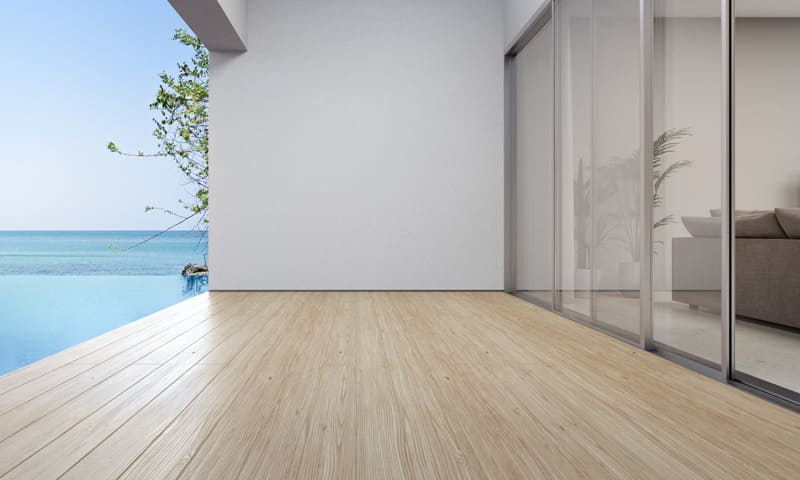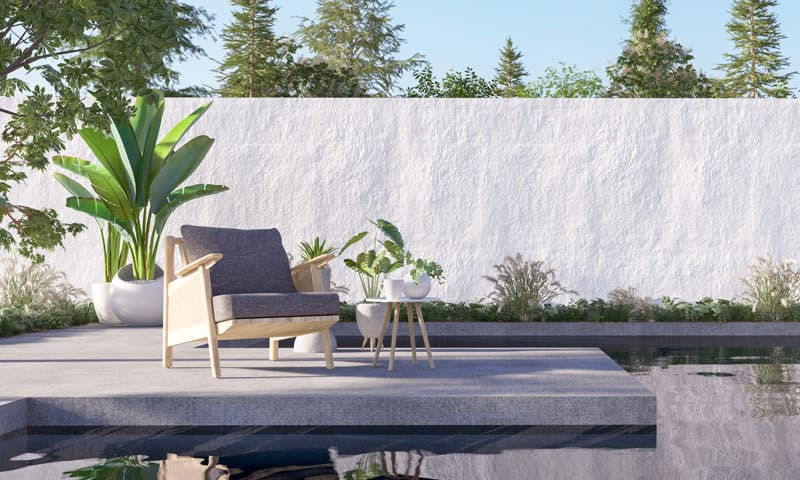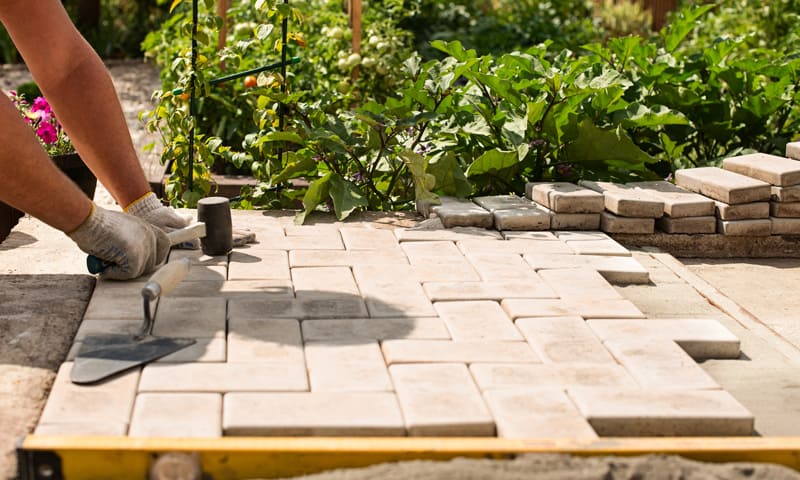Valuation Pro – Now with data back to 1985 + outlook for the next 12 months
View value development now
Everything homeowners need to know — Every first Thursday of the month.


Everything homeowners need to know — Every first Thursday of the month.

Regional craftsmen
Only certified companies
Quality guarantee

Do you want to build a new house or replace your existing balcony, garden patio or terrace flooring? In this article, we summarise for you in a short and easy-to-understand way which floorings are best suited and what you should pay special attention to before deciding on a floor covering for your balcony, garden patio or terrace.
If you are building new and can choose the flooring or want to spice up the flooring for your balcony or terrace, you have a wide choice. By default, the floor of balconies or terraces is concreted. In principle, you could have natural stone or polygonal slabs laid - just like for a garden seating area. But they are very heavy. Therefore, an architect or, even better, a structural engineer would first have to clarify and confirm whether the construction can bear the weight. Wood, which is lighter than stone slabs, makes more sense if you want more than just a coat of paint, a plastic covering or a lawn carpet for your balcony or terrace.
For concrete balcony and patio floors, there are decking boards made of wood or WPC available in specialist shops or DIY stores. Wood plastic composite is made of wood flour and polymers and is more durable than most woods and very long-lasting. In addition, moisture, fungi or mould have virtually no chance. That is why WPC is more expensive than native natural wood, but cheaper than precious wood or thermo-wood. Planks are sold per running metre and are 3 metres long as standard. For a wooden plank you have to reckon with at least 10 francs, depending on the quality and workmanship, for a WPC plank with 30 francs or more.
You can lay decking boards yourself if you are not all thumbs. Look for a simple click or tongue and groove system and let us show you how the system works.
Balconies and terraces have a slight slope towards the water drainage. That's why you don't have to worry about excess water during installation. Most planks also have spacer cams to allow water to drain away and ventilate the floor.

For outdoor flooring that has to withstand wind and weather, native wood species are particularly suitable:
It is important to only install heartwood planks if the floor is exposed to the weather. Heartwood (or colour heart) is the dark inner zone in the trunk cross-section and is more durable than the lighter sapwood. That is why it is better suited as flooring for balconies, garden patios or terraces.
Wood is natural and grows back. You have the choice between native natural wood or exotic precious wood, with or without grains. Walking barefoot on a wooden floor is a sensual experience. Moreover, wood blends wonderfully into all environments or contrasts skilfully with them, for example wood with grains in a modern minimalist environment. On the other hand, real wood is quite demanding. For example, it should be professionally installed and regularly maintained. If not, the planks can swell up quite quickly, rot, become slippery or splinter when exposed to wind and weather.
If you are laying wood in the garden, you may need a substructure. On the one hand, to compensate for unevenness, on the other hand, so that the water runs off and does not accumulate on the house wall.
Thermowoods are refined with heat, which reinforces and preserves their positive properties. That is why they are more durable, more hard-wearing and more weather-resistant than normal wood, but also more expensive.
In many gardens, concrete slabs are laid for the seating area. They are very easy to maintain and dirt can hardly penetrate or be easily removed if you have the surface treated for protection. They are also frost-resistant and can be laid on simple stabilised sand beds because they are heavy. Concrete slabs come in many sizes and thicknesses, with or without texture, grey or coloured, glossy or matt. With large slabs, even a small garden seating area looks large and spacious and all the loungers, chairs and tables stand securely and without wobbling. Large slabs have another important advantage: there are fewer gaps where weeds can grow ...

Natural stone is highly resilient and hard-wearing. Natural stone slabs with low porosity (ratio of void volume to total volume) are easy to maintain because dirt cannot penetrate and remains on the smooth surface where you can simply wipe it away. However, they can discolour over the years under the effects of the weather, which enhances their individual character. However, not every natural stone is suitable as an outdoor floor covering. Slate slabs, for example, can be penetrated by water, which freezes in winter and can break stone because ice has 9 to 10 % more volume than water and therefore expands.
No two natural stones are alike. Natural stone slabs come in many colours, shapes and sizes with inclusions or grains. Basalt, granite, limestone or sandstone are best suited. They are cheap to maintain, easy to care for and very robust. On the other hand, they cost a little more and should be laid professionally, for example by a tiler, master gardener or landscape architect. Ask him about local natural stones. There are more than 70 quarries in Switzerland where granite, marble, quartzite and sandstone are quarried. They cost a little more than stones from abroad, but they don't have to be transported halfway around the globe.
The more the master gardener or landscape architect knows, the more accurate his quote. Is the ground hard or soft, level or uneven? Is there a slope? Do old tree stumps or roots have to be removed? Of course, this also applies to the laying of polygonal slabs.
{{gardener}}
Polygonal slabs are polygonal rather than square natural stone slabs and originate from Southern Europe. Most slabs are 5- or 6-cornered and have an edge length of 25 centimetres or more. Their dynamic shape enhances their natural surface texture. They are particularly suitable for garden seating areas, but also for paths or individual stepping stones in the garden. The larger the garden seating area, the better the effect of large polygonal slabs. They are mainly made of granite, limestone and sandstone, but also of basalt, gneiss, quartzite, slate and travertine, and are very easy to maintain. As with natural stone slabs, by the way, do not use a high-pressure cleaner. The strong water pressure destroys the structure of the floor until dirt can penetrate.
Over the years, lichen and moss can form on the natural stones. The easiest and most gentle way to remove them is with a brush, sponge and water.
Slabs of quartzite or slate are easier to clean than other natural stones thanks to their smooth surface. Granite slabs, which need to be cleaned regularly, are the most difficult to maintain.
Ceramic tiles are in vogue and are being laid more and more frequently outdoors. They are comparable to natural stone slabs, but have other convincing advantages. On the one hand, they are easier to clean and resistant to soiling such as red wine stains; on the other hand, they are thinner and lighter and therefore easier to lay. Furthermore, ceramic tiles for outdoor use are available in different decors, for example in wood or stone look, which match the tiles for indoor use. The prices depend on the size, the material, the decor and the surface treatment. Ceramic tiles are more expensive than natural stone tiles and cost about twice as much as concrete tiles.
You can lay paving stones for the garden patio, but also for driveways, garden paths, house entrances or parking spaces. Depending on the material, they are resilient, frost-resistant, easy to maintain, robust, acid-resistant and waterproof. That is why they are suitable for outdoor use, where they are exposed to the weather 365 days a year. They come in many colours, shapes and materials:
A plan is important. Especially if the paving stones are to form patterns or geometric shapes. Symmetrical patterns are relatively easy. Patterns with different sized stones that have to be laid asymmetrically are more difficult. The most difficult patterns are those with curves, because the paving stones may still have to be cut in the garden. Once the stones are laid, they need to be grouted to fix them in place and finish the area.

Regardless of the material, you should pay attention to these points if you want to lay new or replace flooring for a balcony, garden patio or terrace:

